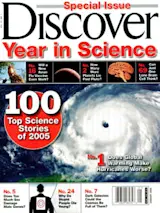America's First Tribe May Have Numbered Only About 200
Researchers have spent decades guessing who peopled the New World. A band of Siberian travelers? Australian immigrants? The specifics remain unclear, but in June population geneticist Jody Hey of Rutgers University made the first real stab at determining exactly how many settlers started it all. The number is surprisingly small. Hey conducted a statistical analysis of short sequences of both DNA and mitochondrial DNA from Chinese, Mongolian, Korean, and Siberian natives. Then he compared them with the same bits in Native Americans, as well as those in Yucatán and Mexican Mayan Indians. By plotting differences, Hey estimated the effective size of the founding population: about 70 adults of reproductive age.
The analysis suggests that a founding tribe of a couple of hundred people (including elderly, children, and others who could not reproduce) may have migrated to North America across a Bering Strait land bridge as recently as 7,000 to 8,000 years ago. That's clearly at odds with archaeological evidence of earlier settlements in the Americas, but Hey says that his analysis simply gives the most likely date. A migration 13,000 to 14,000 years ago, in line with the archaeological data, is also possible. What isn't possible is a far more ancient migration—20,000 years ago or more—suggested by some researchers. "My paper," Hey says, "argues against those older dates." —Kathy A. Svitil
Did Homo erectus Coddle His Grandparents?
Scientists have not been able to determine the exact age at death of a toothless human ancestor found at Dmanisi in Georgia. The gender is also unknown, but the skull's massive browridges suggest the early hominin may have been male.
Archaeologists in Georgia, a former republic of the Soviet Union, have unearthed the ancient skull of an older person who had lost all but one tooth roughly 1.8 million years before dentures were invented. The skull, found underneath the medieval village of Dmanisi, belonged to a human ancestor called Homo erectus, but its gender and cause of death are still unknown. The person survived long enough for his or her empty tooth sockets to change, raising the possibility that the person's relatives cared for the old and infirm. That cultural behavior was not thought to have developed for at least another 1.5 million years.
Researchers say the skull shows that the person had more than just dental problems. "It is clear that this was a sick individual," says project director David Lordkipanidze. "We think this is a good argument that this individual had support from other members of the group." Lordkipanidze says it's unlikely such a person, acting alone, could find enough sustenance to survive the Georgian winter. He believes the people at Dmanisi, who subsisted on whatever meat they could scavenge or kill—"Our guess is that they were quite dangerous hunters"—may have mashed this person's food so it could be gummed.
In August, meanwhile, excavators discovered yet another skull at Dmanisi, home of the first Homo erecti outside of Africa. Most of it is encased in stone, but Lordkipanidze hopes to publish a preliminary description soon. —Zach Zorich
Kennewick Man Finally Studied
After waiting nearly a decade because of legal battles to study the 9,300-year-old human skeleton known as Kennewick Man, anthropologists are getting to know him at last. In July a team of scientists spent 10 days with his bones, trying to shed light on his life and death.
Previous research shows he lived into his thirties or forties and had a broken rib and arm, which both healed, and no cavities in his teeth. A 2.2-inch spear point found in his hip probably did not kill him, but it may hold crucial clues connecting the skeleton to other known cultures of the West—particularly one identified by Cascade points, spear tips that date between 9,500 and 5,000 years ago.
Discovered serendipitously in 1996 along the banks of the Columbia River in Kennewick, Washington, the bones became mired in politics. Several Pacific Northwest Native American tribes requested the bones for burial based on the Native American Graves Protection and Repatriation Act. But a group of scientists disagreed, hoping to study them first. A protracted legal battle ensued. Finally, the Ninth U.S. Circuit Court of Appeals ruled in February 2004 that the federal government failed to sufficiently demonstrate a cultural linkage between the tribes and the skeleton. That opened the way for scientists to visit the Burke Museum of the University of Washington to continue an analysis that may shed light on the origins of the earliest North Americans. —David Wolman














